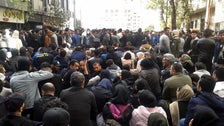
DUBAI (Reuters) – Amnesty International said on Tuesday that more than 100 protesters had been killed in 21 cities in Iran during unrest that broke out over a rise in fuel prices last week.
Snipers have shot into crowds of protesters from rooftops and, in one case, from a helicopter, Amnesty said.
The anti-government protests began on Friday after fuel price rises of at least 50 percent were announced.
An Iranian official said they had subsided on Tuesday, a day after the Revolutionary Guards warned of “decisive” action if they did not cease.
The London-based Amnesty International said that at least 106 protesters in 21 cities had been killed, according to credible reports from witnesses, verified videos and information from human rights activists.
“The organization believes that the real death toll may be much higher, with some reports suggesting as many as 200 have been killed,” Amnesty said in a statement.
The reports “reveal a harrowing pattern of unlawful killings by Iranian security forces, which have used excessive and lethal force to crush largely peaceful protests,” it said.
Intelligence and security forces did not return the bodies to their families and forced others to bury bodies quickly without an independent autopsy, Amnesty said.
Iran’s judiciary spokesman Gholamhossein Esmaili told a news conference that calm had been restored.
But social media videos posted in defiance of an internet block showed protests continued in several cities on Monday night and a heavy presence of security forces in streets. The images posted on social media could not be verified by Reuters.
About 1,000 demonstrators have been arrested, authorities said.
Members of the security forces and police have also been killed in the protests. Three were stabbed to death near Tehran, the semi-official ISNA news agency reported on Monday.
Hundreds of young and working-class Iranians have expressed their anger at squeezed living standards, state corruption and a deepening gap between rich and poor.
Social media footage has shown protesters burning pictures of senior officials and calling on clerical rulers to step down, as well as clashes between security forces and protesters.
State television said funerals will be held for security guards killed in the protests, adding that thousands of Iranians had rallied in several cities to condemn the unrest.
The U.N. human rights office said it had received reports that dozens of people had been killed. It voiced concern about the security forces’ use of live ammunition and urged authorities to rein in its use of force to disperse protests.
“It is clearly very significant, a very alarming situation and widespread across the country,” U.N. human rights spokesman Rupert Colville said in Geneva.
Iran’s Supreme Leader Ayatollah Ali Khamenei on Sunday blamed the turmoil on Iran’s foreign foes, including the United States, and denounced protesters as “thugs”.
On Monday, the powerful Revolutionary Guards warned of “decisive” action if the protests went on. The Guards and their affiliated Basij militia quelled unrest in late 2017 in which at least 22 people were killed.
Frustration has grown over a sharp currency devaluation and rises in prices of bread, rice and other staples since Washington began to apply pressure on Iran to make nuclear and security concessions.
The government said the price rises were intended to raise around $2.55 billion a year for extra subsidies to 18 million families struggling on low incomes.
REAL LIFE. REAL NEWS. REAL VOICES.
Help us tell more of the stories that matter from voices that too often remain unheard.
Credit: Source link